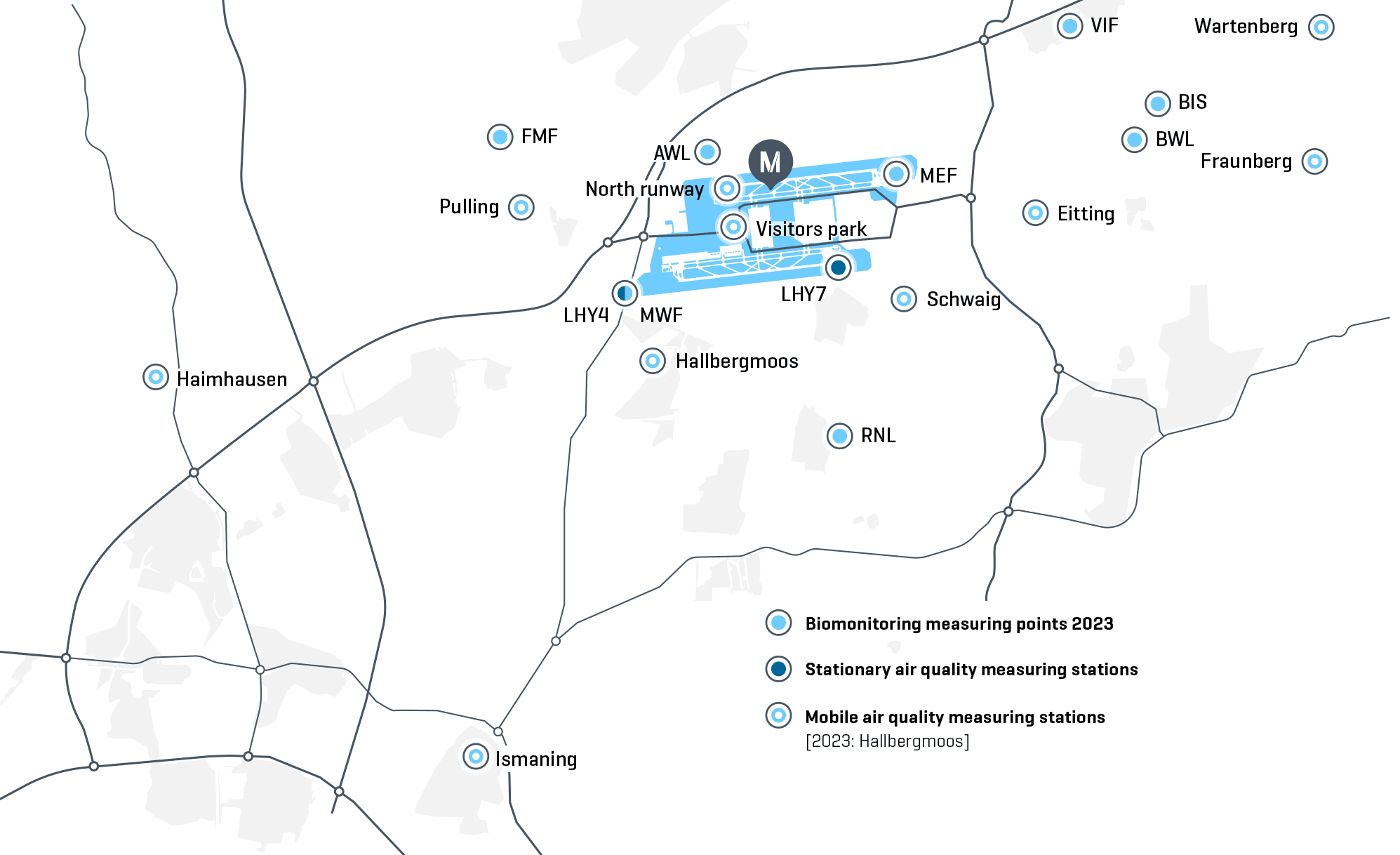Climate protection
CO₂ savings: our path to Net Zero
Traffic figures have continued to recover in 2023. This resulted in an increase in CO₂ emissions attributable to the airport to 92,565 tons. This value is therefore just below the pre-corona level from 2019. In 2023, Flughafen München GmbH invested around 1.4 million euros to reduce greenhouse gas emissions by 2,852 tonnes over the long term through 18 additional individual measures. Thanks to the 351 measures already implemented since 2005, we have been able to reduce our CO₂ emissions by more than 57,000 tonnes of CO₂ per year. With the sharp rise in passenger numbers, specific CO₂ emissions per passenger fell to 2.50 kilograms (Scope 1 and 2) in 2023.
Group Management Report: CO₂ reductions (page 37)
Climate Protection Portal
CDP
CO₂ emissions
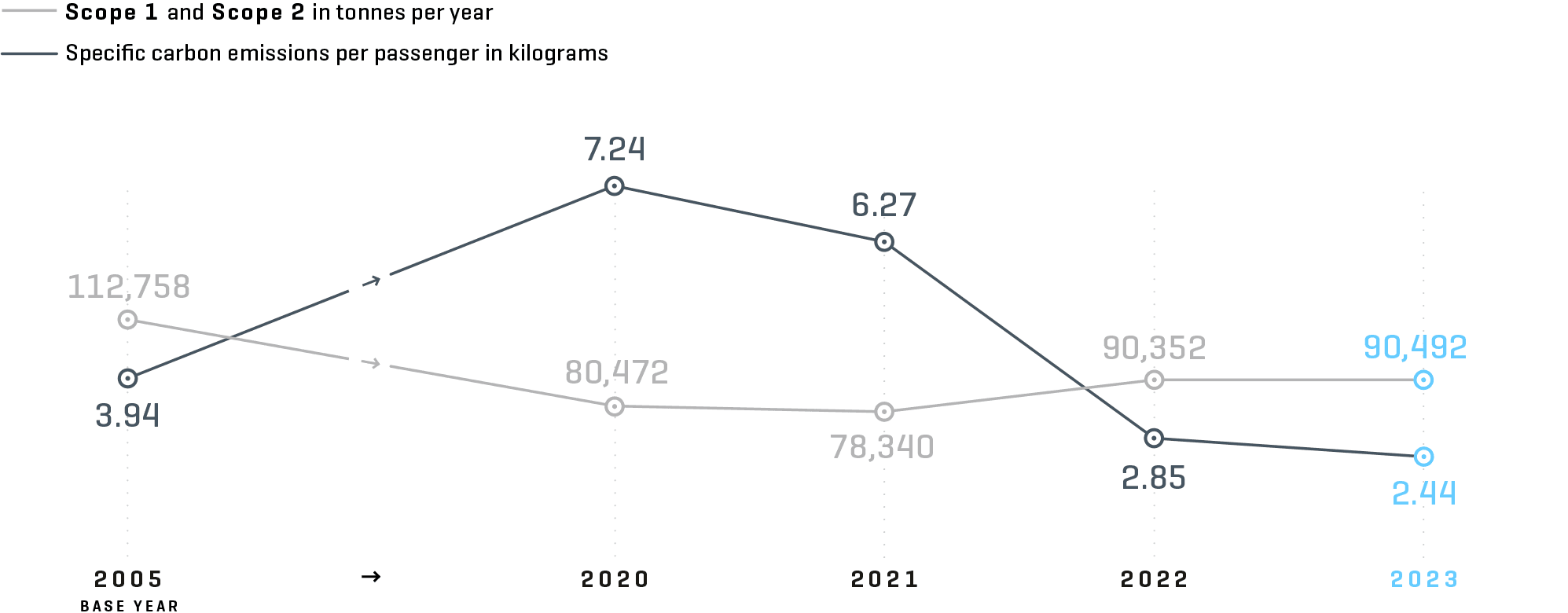

Carbon footprint: a complex math problem
The operation of a large infrastructure facility involves emissions from a wide variety of polluters. They are all included in the balancing of an airport’s greenhouse gas emissions. Emissions from air traffic in the landing-and-take-off cycle (aircraft landing and taking off at altitudes up to 3,000 feet) account for the largest share. The carbon footprint provides the basis for recording all forms of emissions and lends itself to comparison. It breaks down all greenhouse gas emissions that can be attributed to the airport into three different sources (scopes) according to an international standard, the «Greenhouse Gas Protocol».
Greenhouse gas emissions
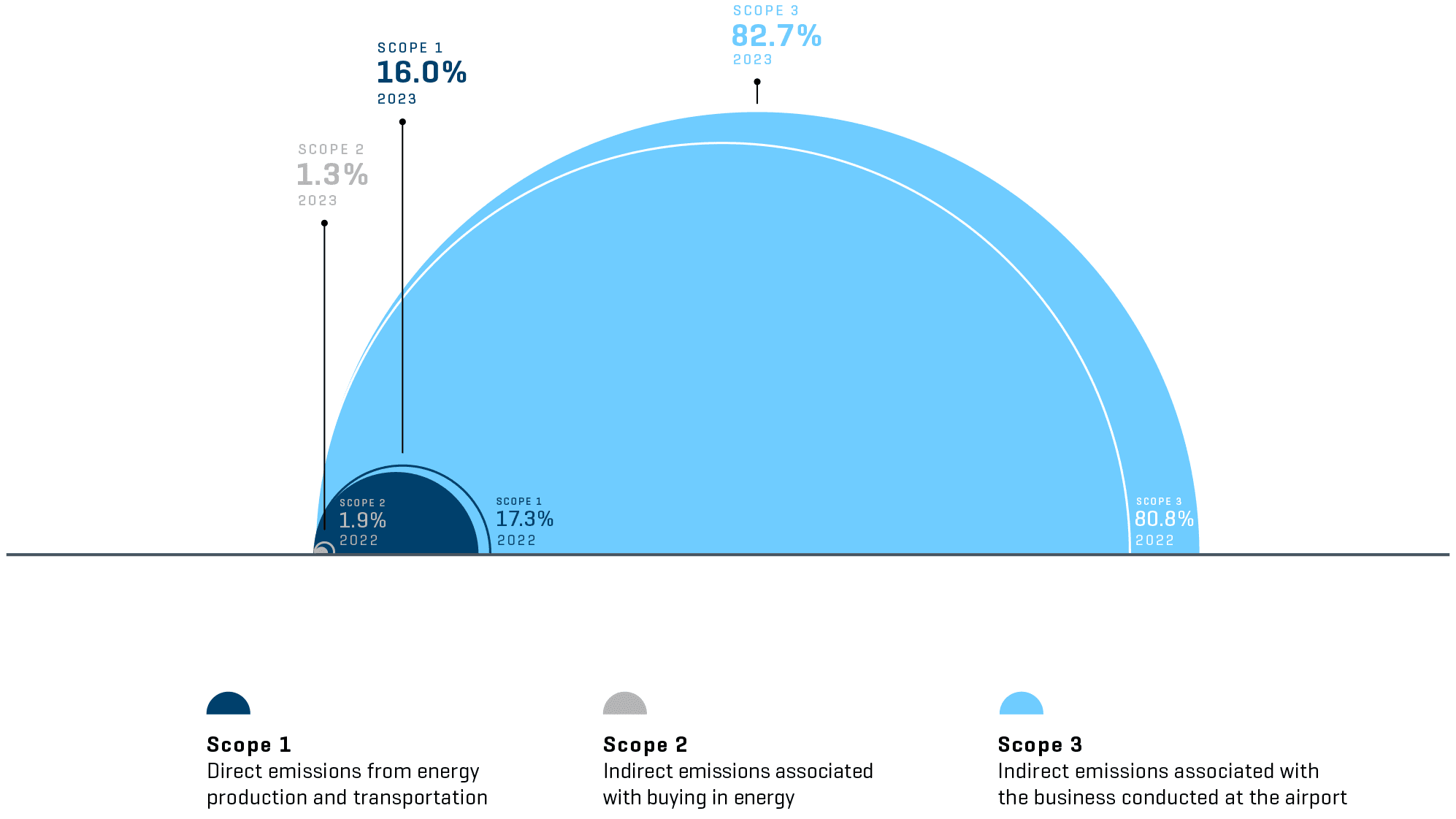

Scope 1 and scope 2
Energy concept: Photovoltaics and biogas as a solution strategy
Munich Airport wants to make almost its entire energy supply carbon-neutral by 2030, using as many available resources in the region as possible. To achieve this, photovoltaic systems with a total output of 50 megawatts are to go into operation on parking garages, freight buildings, and suitable open spaces starting in 2030. Five megawatts of this were already commissioned in 2023. In the future, the primary energy supply of the combined heat and power plant is to be switched to biogas. In addition to climate protection, the high energy prices and dependence on Russian natural gas are another argument for pushing for energy self-sufficiency.
Goal: Expansion of photovoltaic systems
- 20 MW on roof areas
- 30 MW on open areas
- Over 50,000 MWh of solar power
- Equivalent to the electricity consumption of almost 15,000 households or a quarter of Munich Airport’s electricity consumption in the pre-crisis year 2019
- Over 19,000 tons of CO₂ savings per year
Biogas plant


Ecological resource cycle in new biogas plant
Munich Airport plans to use biomethane from biowaste as fuel for its combined heat and power plant in the future. This lighthouse project preserves the principle of cogeneration at Munich Airport.
Special task force uncovers potential savings
At Munich Airport, the «Energy» special task force launched in 2022 continued its work in order to meet the statutory energy-saving requirements and make the best possible use of economic and ecological savings potential. In total, the measures implemented by the special task force will save us around seven GWh of electricity per year at the airport campus.
Top 3 Measures
LEDs to reduce energy consumption
While Munich Airport achieved its greatest savings in the ventilation technology category in 2022, the lighting category took this place in 2023. In particular, the conversion of the parking lot’s interior lighting accounted for around 71 percent of the total savings in terms of lighting. In addition to replacing old light sources with LEDs, optimum lighting control is becoming increasingly important. Brightness control and motion control are effective paremeters here.
Fuel consumption for ground handling vehicles decreasing
The electrification of a total of 64 vehicles – including lift transporters, stairs, towing vehicles, and vans – has resulted in very significant savings in diesel and petrol at the subsidiary AeroGround. This reduced the fuel consumption of the 47 towing vehicles alone by around 200,000 liters per year.
Optimization of the ventilation systems
As in previous years, the optimization of the ventilation systems throughout the campus is being continued. In addition to replacing the latest generation of fans with so-called multi-motor technology, we are also working on reducing pressure losses in the overall system. One example of this is the partial dismantling of large silencers in the ventilation centers and the selective use of downstream silencers in the duct network.
Excerpt from the energy efficiency measures completed in 2023 (Scope 1 and 2)
| Issue | Measure | CO₂ savings per year in tons |
|---|---|---|
| Air conditioning | Conversion of the ventilation systems in Terminal 2 | 386 |
| Conversion of the ventilation systems in T1 and additional buildings | 323 | |
| Lighting | Conversion to LED technology in parking garage P5 | 365 |
| Conversion to LED technology and optimization of the control system in parking garage P20 (construction phase 2) | 267 | |
| Conversion to LED technology and optimization of the control system in T2 | 252 | |
| Vehicles | Electrification of vehicle fleet | 622 |
Electromobility: proportion grows to 37 percent
Munich Airport has already tested various alternative drive concepts. Among them are the launch of the world’s first public hydrogen filling station in 1999 as well as tests with biogas, bioethanol, biodiesel, and C.A.R.E. diesel. In addition, we currently operate 135 cars and vans and 366 handling and special vehicles with electric drives. By 2030, electric vehicles should comprise the lion’s share of the vehicle fleet. In 2023, investments in the procurement of electric vehicles increased again, particularly in the area of handling. Their proportion has grown to 37 percent. With an eye to advances in technology, the vehicle mix will be even more diversified by 2030 through improvements in battery technology, green hydrogen, synthetic fuels, and other alternative drive concepts.
The German Federal Ministry of Digital Affairs and Transport has awarded Munich Airport funding amounting to almost 24 million euros. This grant will support the purchase of up to 72 electrically powered passenger buses, including the necessary charging infrastructure, at Munich Airport. AeroGround, a subsidiary of FMG that is responsible for passenger and crew transportation at Munich Airport, plans to convert its entire bus fleet to electric drive by 2025 and invest up to 60 million euros in the process.
To date, FMG has installed over 600 charging points for both its own pool vehicles as well as for airlines, authorities, the rental car and car-sharing sector, air travelers, and partially for ground handling equipment. By 2030, the plan is to expand the existing charging infrastructure by several thousand charging points. One example is the planned equipping of two parking garages with up to 200 charging points per building. These charging stations are powered by a rooftop photovoltaic system in combination with a powerful energy storage system to efficiently use the energy generated. At the heart of the system is an intelligent charging management system to ensure that the electric vehicles are charged as needed. Here, we are working closely with partners from the industry to drive forward the use of electromobility throughout the airport premises through innovative solutions.
Scope 3
Roof renovation: heat requirement in the hangar decreasing
In 2023, we renovated the energy efficiency of the roof areas on Hangar 1. The optimization of around 30,000 square meters of flat and glass roofs as well as smoke heat exhaust flaps has reduced the building’s heating requirements by around ten percent.
Air quality: consistent monitoring
Nitrogen oxides and particulate matter: at a low level
In terms of air pollutants, as with CO₂, the aircraft cause significantly more emissions than ground traffic on the aprons, as well as feeder and service roads. It is not possible, however, to differentiate between the immissions metrologically. Nitrogen oxides and particulate matter are key factors in assessing air quality at the airport and in its environs. For the measurement of air pollutants, we operate one mobile and two stationary measuring stations. The stationary measuring stations in the west and east of the airport record the effects of pollutant sources from road and air traffic and other airport operations – superimposed on the background pollution of the Munich metropolitan area and the natural background concentration in the atmosphere. The mobile air quality measuring station is used to analyze air quality in the areas requested by various municipalities. Mobile measurements were taken in 2023 on the Volksfestplatz in Hallbergmoos.
In 2023, the nitrogen dioxide concentrations at Munich Airport remained at a normal level for a suburban area. The Covid-19 pandemic brought about a significant decline in concentrations, which has continued despite increasing air traffic. The concentrations of particulate matter at Munich Airport are at a consistently low level and are characteristic of rural areas. Here we can see a clear meteorological dependency: Dry and hot weather favors higher levels of particulate matter. At the two stationary air quality measuring stations and at the mobile one, in 2023, the values were significantly below all applicable legal limits.
Pollutant concentrations at the measuring point to the east of the airport grounds
Annual average values in μg/m3
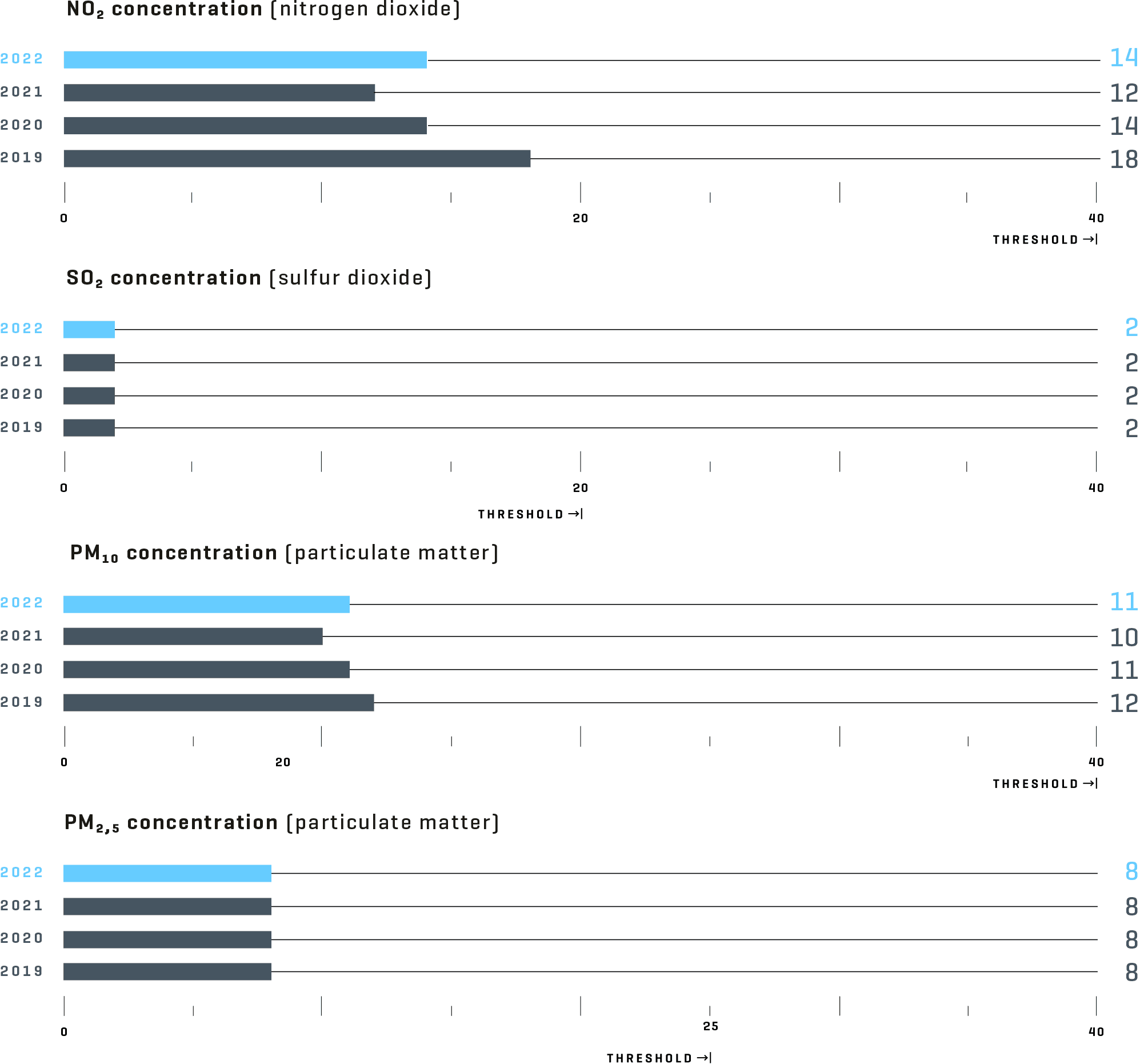
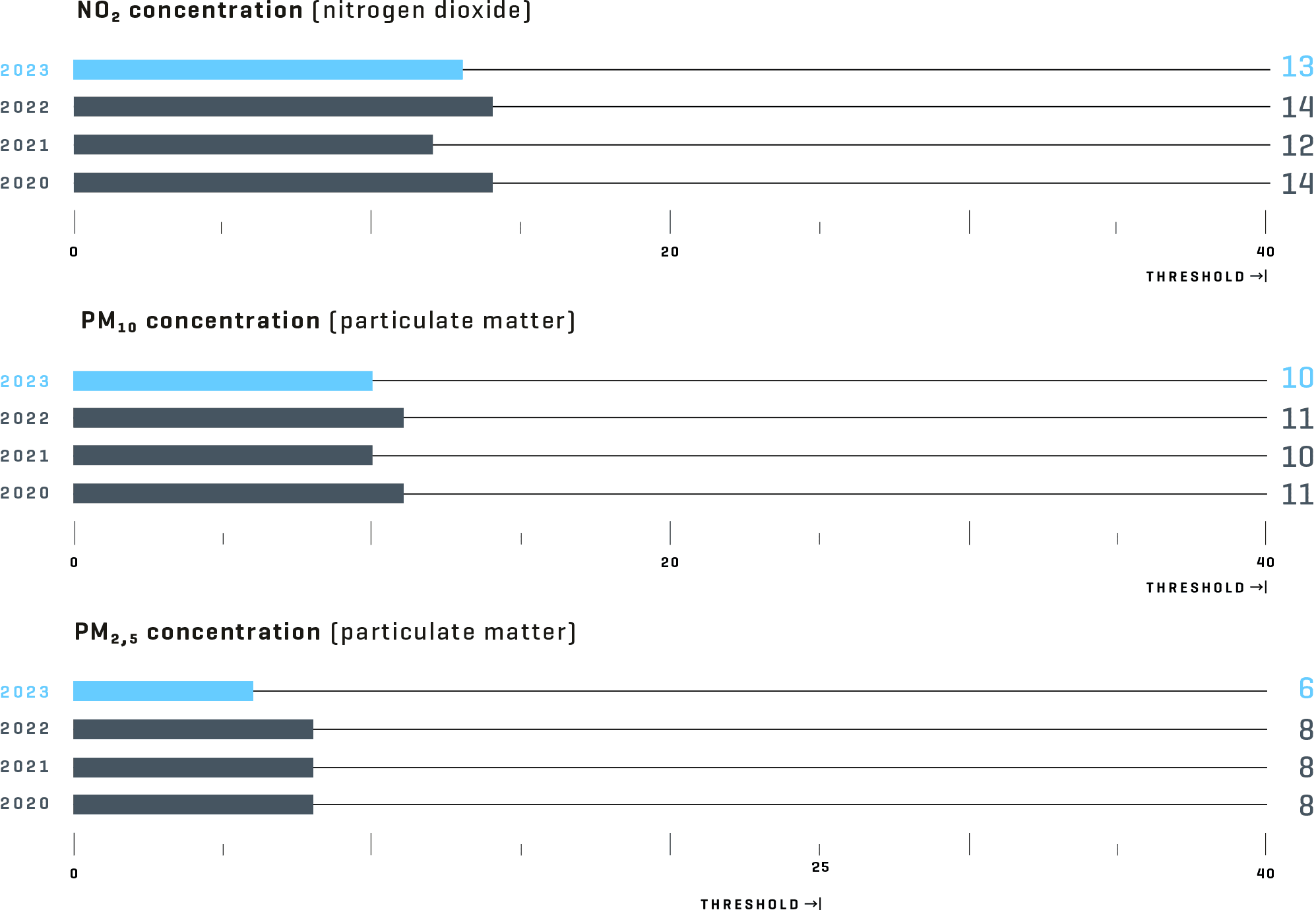
Landing charges: emissions as the basis
FMG charges emissions-based landing charges. Our aim is to motivate engine manufacturers and aircraft builders to invest more in the development of aircraft that produce less in the way of pollutant emissions. Munich Airport is thus helping to better environmental quality in the surrounding area. Based on the types of aircraft that have landed, we can record and assess the pollutants – including CO₂ – for the specific engines, and directly map the technical progress.
Ultrafine particulate matter: a further topic of research
Air traffic is a source of ultrafine particles (UFPs). However, there is currently no objective standard for assessing particle concentrations and no limit values. In the vicinity of Munich Airport, the University of Bayreuth has been measuring the UFP concentration at the Stadtgärtnerei in Freising and at the Volksfestplatz in Hallbergmoos since spring 2021 on behalf of the Bavarian Ministry of the Environment. The Ministry of the Environment has already published the initial results for 2022. Consequently, the concentrations in Freising and Hallbergmoos are at a similar level to those at the measuring stations of the Bavarian State Office for the Environment in Regensburg, Augsburg, and Munich. FMG supports the University of Bayreuth’s measurements with the mobile measuring station at the Hallbergmoos site and collects additional air quality parameters to help interpret the UFP concentrations. FMG does not carry out UFP measurements itself.
Organic honey: 29 bee colonies around the airport
Long-lasting pollutants can accumulate in the environment and therefore seep into the food chain. Munich Airport has been monitoring this situation for many years using a variety of methods. In 2023, plant pots with perennial ryegrass and kale were installed at eight measuring points in the surrounding area in order to investigate the contamination of feed and food in the area around the airport. No abnormalities were found. We also continued our honey monitoring efforts with 29 bee colonies around the airport. Munich Airport honey has been certified «organic» since 2023. It is the first honey from a German airport to meet the requirements of the «DE-Öko-037» labeling regulation and is permitted to feature the EU organic seal and the German organic seal on its label.
Measuring points air quality and biomonitoring
